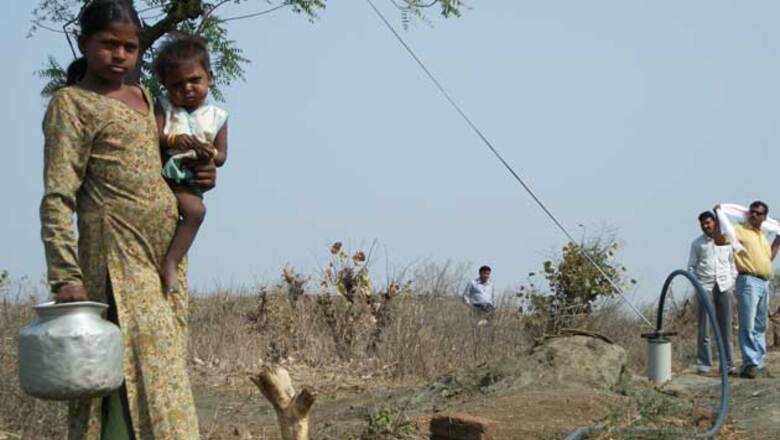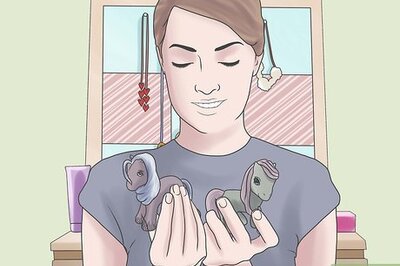
views
India is conducting its first caste census since 1931, but will it be counting the homeless and the destitute; the nomads and pastoral communities and the wandering de-notified tribes stigmatized as criminals by birth; its fifty million denizens. Sumit Pande reports.
“Thirteen months and fourteen days,” I said.
“No; no. It is fourteen months and thirteen days”; Dhaneshwar Bhonsle corrects me, almost taking umbrage at the factual oversight.
For a man falsely implicated of murdering his aunt- mother’s sister- each day he had spend in Solapur jail counts. The ignominy has since been washed away by the acquittal. The scars remain.
“I was picked up by police because that’s the easiest way to solve a murder. I am a pardhi, the criminal caste as they still call us”; Bhonsle tells me quoting extensively from the sessions court judgment exonerating him of all charges. For any pardhi, this proof of innocence is a prized possession; especially in a system which declares him guilty till proven otherwise.
“We exist in government records only as criminals. We need to be treated as citizens. We need an identity, a new identity”; he tells me, the pique writ large in his voice.
That is precisely what Bhonsle and some of his friends are now working to achieve for their community in the Marathwada region of Maharashtra. His dedication and perseverance is slowly bearing fruits with more than ten thousand of his ilk getting the right to vote just ahead of the assembly elections last year.
These are men and women: branded by history and forgotten by the state.
Solapur’s “settlement colony” still carries the burden of the imperial pronouncement. Thousands- ostracized as criminals by birth; and not by their acts- were incarcerated here for reformation in British India.
This was done as per the Criminal Tribes Act of 1871 or the CTA. The Act draws a schedule of castes and tribes and lists them as habitual offenders. Most of these tribes were nomadic or semi-nomadic in nature. Settlement colonies- the biggest one was in Solapur- were built under the statute as reformatory for men and women condemned for their entire life. A subsequent amendment to the Act had a provision to separate infants and minors from their parents.
The imperial opinion and the inception of the CTA is so very categorically delineated by Mount Stuart Elphinstone- the British historian who later served as the Governor of Bombay- in History of India (1841):
“It need scarcely be said that the long descent of the thievish castes give them no claim on the sympathy of the rest of the community, who look on them as equally obnoxious to punishment both in this world and the next ".
It was made mandatory for these “criminal tribes” to register themselves with the authorities wherever they were, and the offenders were interned in settlement colonies. Living conditions in these camps were in-human. This is what the Report of the Criminal Tribes Act Enquiry Committee says after inspecting the Solapur settlement in 1939:
“For a combined population in the settlement proper and the free colony of over 3,600 the arrangement for water supply and sanitation were extremely inadequate. No supervision or an attempt to secure improvement appeared to have been made in the building of huts by settlers and the general lay-out of the settlement presented a desultory appearance.”
The CTA was repealed after Independence on the 31st of August, 1952. The tribes listed in the Act were de-listed or de-notified. These communities in the official lexicon thus came to be known as de-notified tribes or DNTs.
Subsequently in most of the states, DNTs were either included in the Scheduled Castes or the Scheduled Tribes list. The rest were clubbed with the Other Backward Castes or the OBCs.
In Maharashtra however, no such provisions was made.
After a protracted agitation, DNTs were later appendage with the SC, ST or OBC list. The rest (14 tribes out of the total 28 in the CTA for Maharashtra) were clubbed and recognized as Vimukt jati or de-notified tribes and given a separate 3% reservation in state services and educational institutions.
Affirmitive action
Parsanta Pawar is oblivious to the change she has ushered in her little tanda or hamlet situated at periphery of Mangural Cahavala village in the Amravati district. The phasi pardhi (de- notified tribes known for hunting and way- laying) woman took on (quite literally) a district education official for denying her access to water from a public well near the village school.
Though arraigned both by her community and the state authorities for the “insolence”, she did not budge. Government ultimately had to transfer the official to another taluka.
“We won the battle but lost the war. The officer was punished for assaulting my wife; at the same time our panchayat slapped a fine of Rs.10,000 on Parsanta for having being “defiled” by a rank outsider”; rues her husband Dhirun Pawar.
Money was arranged by selling the family livestock. The conflict has since triggered a catalytic change in this hutment of about three dozen pardhi families.
The community raised funds through donations and now enjoys round the clock water supply from a bore well right in the middle of their settlement. Emboldened by the success of this first venture, some individuals approached the district Tribal Welfare department to obtain grants for cattle raring.
“The most disappointing part in this success story was the refusal by neighbouring villagers to buy milk products from the pardhis. We finally had to intervene by asking government dairies to purchase their milk”; says G P Garad, Additional Commissioner Tribal Welfare Department.
For most of these communities lagging woefully behind other castes in every aspect of human development, especially education, the affirmative action has meant little. Their nomadic tendency makes it virtually impossible to obtain a resident proof, be it the voter identity card or the BPL cards, excluding them from the purview of any welfare scheme.
Population
The last caste census in India was conducted in 1931. The population of the Bombay Presidency in the census is recorded as 2 , 63 , 98, 997 which is 27.28% of the then national aggregate. The document has also listed 28 de-notified castes in the presidency and their corresponding population as 11,75,459. The DNTs thus comprised nearly 4.45% of the total population in the province.
In the last eighty years, the Bombay Presidency after multiple chops and affixations has had its contours drawn and redrawn to reshape into a linguistically homogeneous state of Maharashtra. In 1931, the administrative monolith extended from Gujarat/ Sindh in the North to Nizaam’s Hyderabad in the East and Madras Presidency and Arabian Sea on its South and west respectively.
Thus it is rather difficult and farfetched to draw an empirical inference on the current population of the DNTs in Maharashtra in particular and India in general.
Former Chairperson of the National Commission for the De-notified and Nomadic Tribes Bala Krishna Renke in his report has extrapolated it be somewhere between 10 to 12 crores.
“This was done by taking into account the 1931 census records; the last decennial census of 2001 which enumerated DNTs falling in the SC/ST category. But we would still want the government to have a proper count done”; Renke insists.
The report submitted by the commission recommending the headcount to be undertaken along with national census currently underway is now lying in a deep freeze.
“57% DNTs are not in the voters list. 98% are landless. They can not even prove that they are Indians”; Renke complains.
Nyuroopi Pawar in Piranada tehsil of Osmanabad district is a phase-pardhi who now has a permanent residence address. The government provided him one as a part ex-gratis compensation after the broad daylight lynching of his son Rakesh.
Rakesh was stoned to death by a mob near their village in December last year on the suspicion of a robbery. His mother survived with serious injuries on her head.
“There are many alibis. Rakesh was present in the school when the crime he was accused of was committed fifty kilometers from here”; says Ashok Thabe, in-charge of the residential school at Yamgarwadi where Rakesh was enrolled in Class 10th standard.
Most of the assailants in the case have been arrested, but the Pawar family is afraid to move into their new house.
“They are powerful people. Very powerful.”; Pawar tells me when I met him outside sub-divisional magistrate’s office at Piranda.
Both fear and stigmatization has driven the DNTs in this country to oblivion. When the headcount or the enumeration is undertaken in February, 2011 after the house-listing exercise currently underway, it’s not clear whether xxx Pawar; his family and millions like him will be counted or not.
Maharashtra census
In Maharashtra, the house- listing exercise for the 2011 census started from the 1st of May. In the first leg, all the households will be counted; and the concomitant data for the preparation of a National Population Register will be collated.
But what will happen to those who have never had a permanent address? Nor have their fathers or forefathers- the nomads, semi- nomads or pastoral communities; and the de-notified tribes?
“Yes, these are issues which will have to be taken into account. I had raised the matter while interacting with census authorities. In my district alone there are nomadic tribes which migrate form Solapur in Maharashtra to Karnataka and then to Andhra Pradesh”; says Solapur collector Dr Jagdish Patil.
The matter assumes far greater significance in the current context with the country preparing a National Population register along with the census enumeration and the household listing. The ambitious Unique Identity Cards or UID has also been linked to this exercise as the government prepares to exhaustively utilize these cards in the identification the needy for effective and focused implementation of the welfare schemes.
“I am worried more about the nomads. Many statutes like the Prevention of Beggary Act prohibits traditional acrobats like nuts, dombharis etc to earn a living by the public display of their skills. Driven away from their traditional source of livelihood, they are constantly harassed by the police”; says Bal Krishna Renke.
Epilogue
For conducting the decennial 2011 census, an elaborate procedure and programme has already been laid out. In the first leg already underway, households would be listed across the country to gather information for the preparation of a National Population Calendar or NPR. The final enumeration will be conducted in the second and the third week of February, 2011.
The census exercise in India takes house- hold as an elementary unit for enumeration. For the homeless, the enumeration will be conducted on the night of 28th February when officials and groups, NGOs with police escort will be pressed into service.
The office of the Registrar General and Census Commissioner while explaining the census operations clearly underlines the problem and risk associated with this particular exercise to be undertaken at the fag end of the enumeration. Since most of the DNTs either live in secluded spots or in “illegal” temporary constructions, any last minute attempt to approach them may further drive these communities away from enumerators.
For a country which proposes to channelise most of the welfare schemes through the biometric Unique Identity Cards, to overlook its homeless, its floating nomadic and pastoral population, the historically condemned castes would not only be a travesty of justice.
It would be criminal.
Postscript
The report has been filed based on the field work in Maharashtra’ Mrathwada region, though atrocities against DNTs is reported across the length and breath of the nation. The Reneke Commission for DNTs has listed nearly 575 such tribes –most of them having lost their traditional modes of livelihood to the fast changing economic environ are in dire straits.
(CNN-IBN's Sumit Pande is doing a series of reports on small/marginal farmers and denotified tribes. The series is funded by Inclusive Media for Change, or im4change, of the Centre for the Study of Developing Societies)


















Comments
0 comment